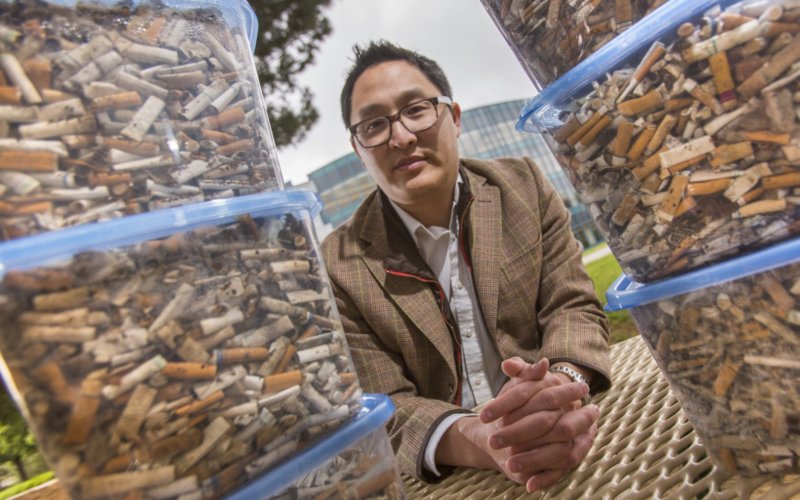
A few years ago, Joshua Yang, assistant professor of health science, noticed that smokers on campus often tossed their cigarette butts on the ground when they were finished — instead of in the ash cans provided for that purpose.
“People often don’t think of cigarettes as environmental litter but, of course, they are,” he said.
Yang devised a project for students in the Student Health Promotion Honors Society. For one hour on a Saturday afternoon, the volunteers would scour the campus, looking for discarded cigarette butts. They didn’t have to search long … or far. At the end of the hour, volunteers had picked up thousands of cigarette butts.
Recently, Yang repeated the experiment. This time, 13 volunteers, again in a one-hour period of time, reported picking up 7,641 butts, some just inches away from an ash can.
“It’s not as if the campus is covered with cigarette butts,” he said. “But they do add up. In fact, cigarette butts are the most collected waste in beach, city and river cleanups.”
In fact, recent estimates in a study published in the Tobacco Control Digest suggests that there are 5.6 trillion cigarette butts deposited in the global environment each year.
But don’t the butts eventually just disintegrate?
“What most people don’t realize is that the butt is made of cellulose acetate — a plastic,” Yange said. This can degrade but it can take at least nine months under optimal conditions.”
In the meantime, cigarette butts often attract the attention of animals, birds and small children who can ingest the materials if not stopped in time.
“I don’t think there’s anyone who would recommend feeding toxic waste to any living creature,” said Yang. “We don’t know all the hazards that animals experience by eating these butts but we do know it can’t be good for them.
“Tobacco fosters problems everywhere,” he said. “First, it’s a known health hazard. Secondly, it impacts the environment and not just with its byproducts (i.e. cigarette butts). The growing of tobacco leads to deforestation in some areas to allow room for the product to be grown, as well as the wood that is cut so the tobacco can be dried and cured. Then there are chemicals released by tobacco-manufacturing facilities. There are wide-ranging effects to tobacco production.”
Once the students picked up the thousands of cigarette butts, Yang wanted to keep them for an exhibit in an upcoming student health fair. He put the large, plastic bag of cigarette butts in a cleaning closet near his office. A few days later, he was asked to remove the bag because the tobacco odor was so strong and was bothering others.
“Nobody was getting second-hand smoke from the cigarette butts but it’s still a very unpleasant smell,” Yang said. “There’s just nothing good that comes from smoking cigarettes.”